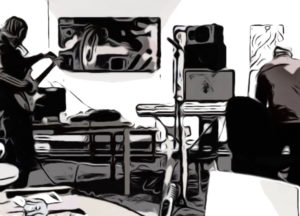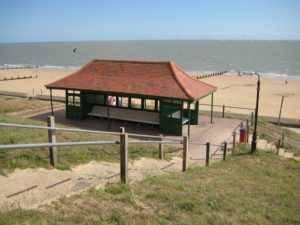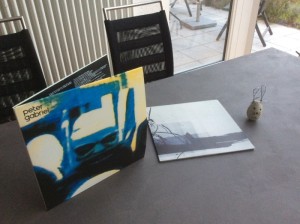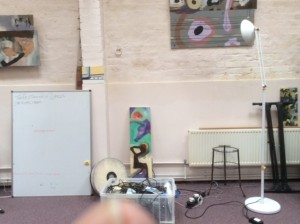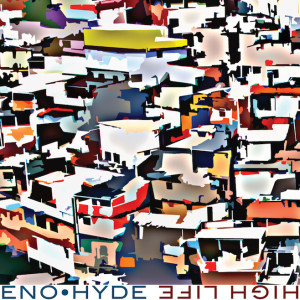When I entered Brian Eno’s studio in West London on a sunny, early April morning, he was just working on an idea in his head (a special sound maybe, a rhythm, a melodic shape?). I was quiet for a moment so that he could make a mental note. – You look a bit Moroccan, I then said to him. I’ve never seen Brian Eno with a white beard before. He really was in the Moroccan hills a short time ago. What I didn’t know was that he bought a hat there – in that country that was once a “hippie dream world” deep in the last century, but which turned to hell for too many young people. I have known Brian since 1989, and when I’m in London, there are casual meetings once in a while. This time Brian and Karl would play a „concert for one“, happily for me, two days later. When I left the studio, with a copy of SOMEDAY WORLD, I saw Brian setting a pulsating electronic rhythm in motion. Always fun to hear a glimpse of a possible future. Hope he was able to – nearly seamlessly, return to the idea he had in his mind – meaning the completely different place he had been some minutes before!

On Feb. 28th Karl Hyde wrote down three sentences, entitled IN A TROPICAL COCOON: „Old man wheeled in a chair through the Aroma of exotic streets wearing a distant expression. The stories he has written slip away, will be forgotten. They lie behind him in a trail of ghost memories, in the market on Pagoda street.“ An accidental observation, a dream sequence? Who knows? Karl Hyde has the knack of getting lost in special moments and sceneries of modern life, focussed on things that might otherwise disappear before you really see them. Brian Eno is his companion in creating disturbing, beautiful songs with a sense of wonder and wilderness in SOMEDAY WORLD. Brian (also fond of notebooks and diaries) knows how to look for exit signs on old, well-trodden paths. Getting lost is a heartfelt need. For both of them. Between the blurred edges of England’s old soil and another blue world „The satellites sing songs / The days run into one / I need the sound of cars / To drown the quiet sun“.

Michael Engelbrecht: In the 70’s one of your four so-called song albums of that decade contained the word „world“, „Another Green World“, a work full of exotic landscapes. In 2005, „Another Day On Earth“suggested a return to the real life on this planet, and your new collaboration with Karl Hyde, „Someday World“ again seems to cover existential issues. I just have to look at the cover, a strange, kind of psychedelic picture.
Brian Eno: I think it’s an optimistic choice. It’s the idea of a world that might actually turn out to be okay in the end. To everybody’s surprise, it might be a good world, there’s still a chance. In fact the record started out with quite a different mood. It ended up somewhere much more positive and joyful than really the place it began. I mean we weren’t miserable when we started, but there was a sort of slightly angry energy, as we started working together, but, because we were enjoying the process so much, the record actually came out with a lot of that joy in it …
Michael: … that is often undermined with rather dark undercurrents, in the lyrics, for example.
Brian: One of the things I like about the result is that two different sets of emotions are stuck together, and they can actually coexist. I always like things when I think, when I feel they are emotinally complicated. I don’t really like emotionally simple art (laughs).
Michael: When moments of anger or despair are mixed with euphoria, you can call it „hysteric“ in the field of Clinical Psychology. Here the songs all get a second or even third bottom. They seem to be alive and well, despite some of the more or less hidden shades of disturbance and sadness.
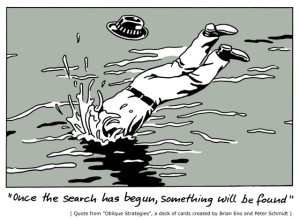
Brian: Yes, you’re quite right. You asked about the cover of the album, that’s very much the picture of the cover as well. It’s a picture of a bit of a railway line actually, and it’s a very industrial, not attractive landscape in a way. It looks like a vision of a place you wouldn’t want to live. But in fact by making that kind of false world behind it, it suddenly suggests that it might be a kind of utopia. And I think in the song „A Man Wakes Up“ the same thing happens: the guy suddenly realizes that he’s very happy, he’s very fulfilled. I have this experience sometimes when I remember times in the past, and I think, ah, that was a great time, I was really happy then … If I go and look at my diaries or my notebooks, I’m always complaining (laughs). So these times when actually I was really enjoying it, I thought that things weren’t so good, you know, my perception of the time was, this is a difficult time, my perception in retrospect is – that was a great time. Nearly all the times have been great, actually …
Michael: Nevertheless, missed opportunities seem to be one recurring topic of „Someday World“, for example in the song „Witness“. We can hear this frenetic singing: „Did you ever loose your faith for a day / Seeing everything slip away? / Did you ever take a bribe? / Or a ride, a ride, a ride along a road / You’d taken all your life / Only to find it didn’t go to the place you thought it would arrive.“ Apart from that it seems to be a love song where someone is missed in the early hours after midnight …
Brian: I don’t think it’s about a romantic relationship, or at least it shouldn’t only be about that. It could be about that as well. It’s about a relationship. It could be friends, or lovers, we don’t know. The song doesn’t tell you, and I think it shouldn’t really tell you which one it is. What is exciting to me about that song, there’s a sort of yearning feeling to it … somebody wanting something so badly that they can’t see that it’s already there (laughs). Maybe that’s the feeling I get from it.
Michael: Karl and you have both shared the writing of the lyrics. Nevertheless certain motives do appear or reappear during the nine songs. Stars and cars particularly. In „Daddy’s Car“, a dreamy evening atmosphere of playing children and the speed of a car on a highway are set against the tremendous speed of the North Star. Did you plan certain leitmotivs?
Brian: (laughs) Cars and stars, that had been another nice title. But, no, I’ve just noticed it now you say it. But it’s certainly Karl’s subject matter. The kind of things he likes to write about. Ordinary things, things that you see in your life, people you hear on buses, a lot of the text comes from him listening to people having conversations in buses or shopping centers, and he just writes down what they’re saying. He got hundreds of those books. He just takes lines and fits them together, and sometimes I add something in or write some parts as well.
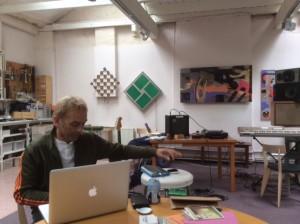
Part 2/4
Part 3/4
Part 4/4
